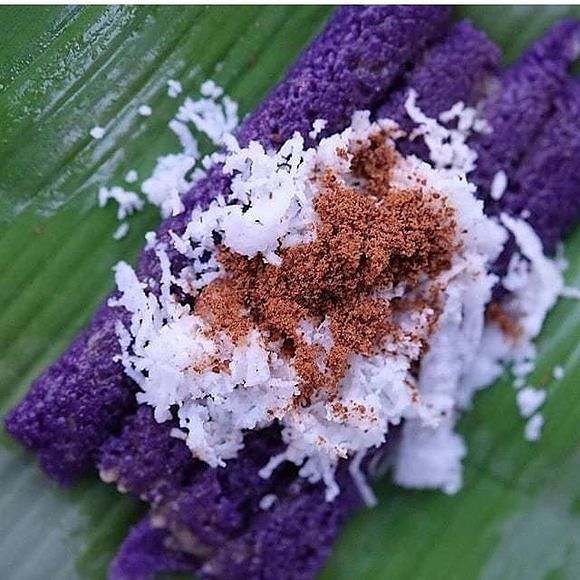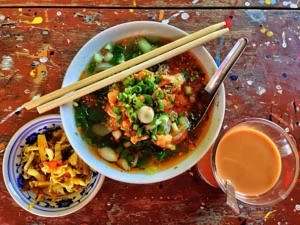The Unique Tastes of Filipino Cuisine
Filipino cuisine in the culinary world
Filipino cuisine, stands out in the culinary world for its unique blend of flavors and influences. This cuisine is a reflection of the country’s diverse history, with each dish telling a story of the islands’ Malay, Chinese, Spanish, and American heritage. Filipino food is characterized by its use of simple, fresh ingredients to create dishes that are rich in flavors, appealing to a wide range of palates.

The Blend of Flavors
The hallmark of Filipino cuisine is its combination of sweet, sour, and salty flavors, often within a single dish. This distinct taste profile is achieved through the use of indigenous spices and ingredients, such as calamansi (a small, tangy citrus fruit), coconut vinegar, and patis (fish sauce), creating a culinary experience that is truly Filipino.
[wpzoom_rcb_post id=”1355″]
Historical Influences
Filipino cuisine is a melting pot of cultural influences. The Malay introduced indigenous cooking methods and ingredients, the Chinese brought their noodles and lumpia, the Spanish contributed their complex stews and rich desserts, and the Americans introduced canned goods and fast food. This fusion has resulted in a unique culinary tradition that is rich in history and flavor.
Staple Ingredients
Rice is the foundation of Filipino cuisine, served with every meal. Coconut is used in various forms, from milk to grated meat, adding richness and depth to dishes. The abundant seas surrounding the Philippines provide a plethora of seafood, a staple in the Filipino diet. Tropical fruits, such as mangoes, bananas, and pineapples, are also key components, used both in dishes and as snacks.
Iconic Filipino Dishes
Filipino cuisine boasts a variety of iconic dishes. Adobo, with its vinegar and soy sauce base, is a national favorite. Sinigang, a sour soup, exemplifies the Filipino love for tangy flavors. Lechon, a whole roasted pig, is the centerpiece of celebrations. Halo-halo, a mixed dessert of shaved ice, milk, and various toppings, offers a sweet conclusion to Filipino meals.
[wpzoom_rcb_post id=”1365″]
Regional Variations
The Philippines’ diverse geography has given rise to regional specialties. Bicol Express from Luzon features spicy coconut cream. Visayas’ Kinilaw is a raw seafood dish similar to ceviche. Mindanao’s Tiyula Itum, a black soup, highlights the Islamic influences in the region. These regional dishes showcase the variety and richness of Filipino cuisine.
Street Food and Snacks
Filipino street food is an integral part of the culture. Balut (fertilized duck egg), kwek-kwek (deep-fried quail eggs), and isaw (chicken intestines) are popular snacks that offer a taste of the country’s adventurous culinary spirit.

Filipino Festive Foods
Festivals and celebrations in the Philippines are marked by special foods. Puto bumbong and bibingka, rice cakes traditionally served during Christmas, and the ever-present lechon, are just a few examples of festive foods that bring families and communities together.

Cooking Techniques
Filipino cooking employs a variety of techniques. Grilling, or inihaw, imparts a smoky flavor to meats and seafood. Stewing, as seen in dishes like nilaga, allows the ingredients to meld together, creating rich and comforting flavors.
Filipino Desserts and Sweets
Desserts and sweets in the Philippines range from the icy halo-halo to the caramel-topped leche flan. These treats are not just delicious but also reflect the country’s history and the Filipino penchant for celebration and sweetness in life.

The Role of Food in Filipino Culture
In the Philippines, food is more than sustenance; it’s a way to bring people together. Family gatherings, festivals, and celebrations are incomplete without a feast, making food a central part of Filipino culture and community.
What Makes Filipino Cuisine Unique?
What sets Filipino cuisine apart is its ability to blend diverse influences into a coherent and delicious whole. The sense of community and sharing that accompanies Filipino meals, along with the distinct flavor profiles, make Filipino cuisine truly unique.
The Global Influence of Filipino Cuisine
Filipino cuisine is gaining recognition worldwide, with restaurants and chefs introducing Filipino flavors to international palates. This global presence not only showcases Filipino culinary creativity but also fosters a greater appreciation for the cuisine’s depth and diversity.
The Future of Filipino Cuisine
The future of Filipino cuisine looks bright, with modern interpretations and a focus on sustainable cooking practices. Chefs, both in the Philippines and abroad, are exploring new ways to present Filipino dishes, ensuring that the cuisine continues to evolve while staying true to its roots.
Filipino cuisine is a celebration of the country’s history, diversity, and the warmth of its people. It offers a unique culinary experience that is rich in flavors, traditions, and stories. As more people around the world discover Filipino food, it continues to be a source of pride and joy for Filipinos everywhere.
FAQs
What are the key flavors of Filipino cuisine?
Filipino cuisine is characterized by a harmonious blend of sweet, sour, and salty flavors, often with a hint of bitterness or spiciness to add complexity. Ingredients like vinegar, soy sauce, garlic, ginger, and coconut milk are staples, contributing to the distinct taste profiles found across various dishes. The use of local fruits, such as mangoes and pineapples, adds a natural sweetness and acidity that is unique to the cuisine.
How do historical influences shape Filipino food?
Filipino food is a rich tapestry woven from various historical influences, predominantly Malay, Chinese, Spanish, and American. The Malay introduced indigenous cooking methods and ingredients. Chinese traders brought in noodles, soy sauce, and stir-frying techniques. Spanish colonization left a legacy of dishes cooked with garlic, onions, tomatoes, and olive oil, alongside festivities featuring roasts and stews. American occupation introduced canned goods, wheat, and dairy products. Each influence has melded into what is distinctly Filipino cuisine today.
What are some must-try Filipino dishes?
Adobo – A savory stew of meat (usually chicken or pork) marinated and cooked in vinegar, soy sauce, garlic, and spices.
Sinigang – A sour soup flavored with tamarind, tomatoes, and various vegetables, with either pork, fish, or shrimp.
Lechon – Whole roasted pig with crispy skin, often served at celebrations.
Pancit – Noodles cooked with soy sauce, vegetables, and sometimes meat or seafood.
Halo-halo – A dessert made with crushed ice, mixed fruits, beans, and milk, topped with ice cream or leche flan.
Why is rice so important in Filipino meals?
Rice is the cornerstone of Filipino cuisine, serving as the main source of carbohydrates and a staple at every meal. It complements the flavors of various dishes and is considered a symbol of life and prosperity. Rice’s versatility is also showcased in Filipino snacks and desserts, like suman (rice cake) and bibingka (rice pancake), highlighting its cultural and culinary significance.
How does regional diversity affect Filipino cuisine?
The Philippines is an archipelago with over 7,000 islands, leading to significant regional diversity in its cuisine. Geographic and climatic variations influence the availability of ingredients, resulting in distinct dishes and flavors in different areas. For example, the Bicol region is known for its spicy and coconut-rich dishes, while the Visayas are famous for their seafood and sweet desserts. This diversity reflects the rich cultural heritage and varied natural resources of the Philippines.
What role does food play in Filipino culture?
Food is central to Filipino culture, symbolizing hospitality, community, and family. It is an integral part of celebrations, festivals, and everyday life, serving as a way to bring people together and express care. Filipino cuisine is not just about nourishment but also about preserving traditions and showcasing regional identities. Sharing a meal is seen as an act of bonding, making food an essential element in fostering social connections and cultural heritage.






